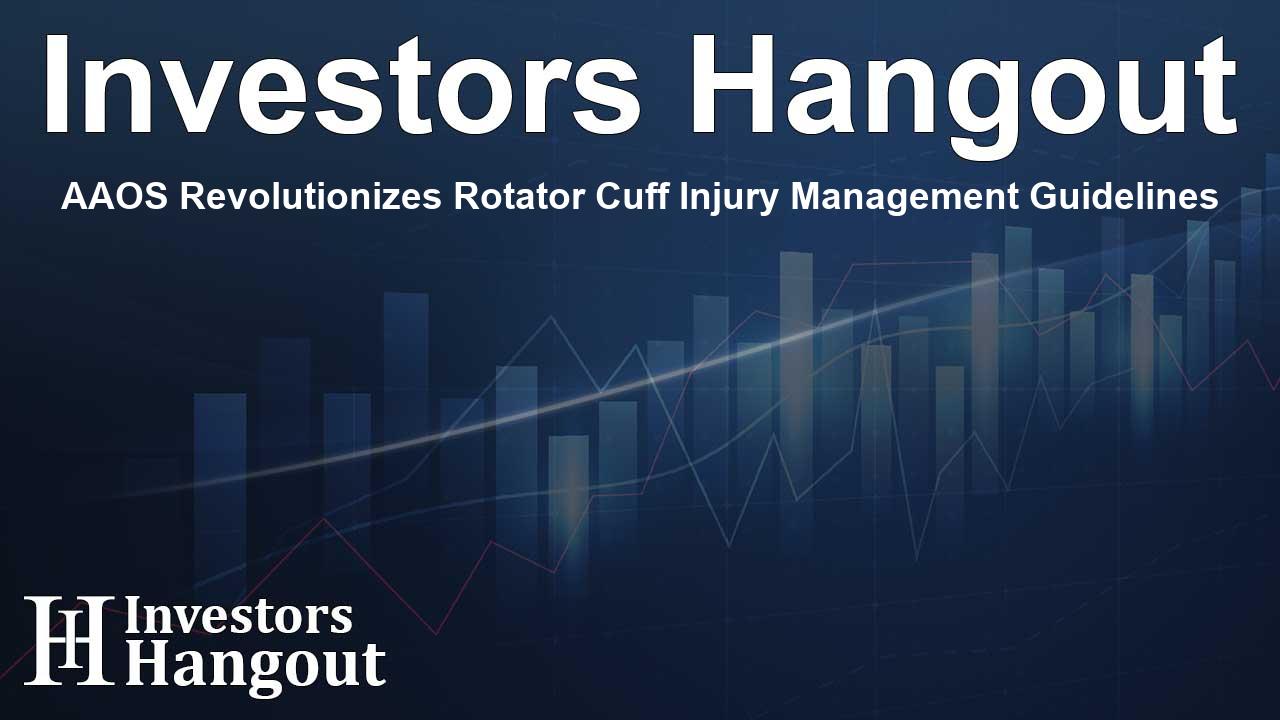AAOS Revolutionizes Rotator Cuff Injury Management Guidelines

Important Updates to CPG for Rotator Cuff Injuries
The American Academy of Orthopaedic Surgeons (AAOS) has recently introduced an updated Clinical Practice Guideline (CPG) for the Management of Rotator Cuff Injuries, replacing the previous 2019 version. This guideline emphasizes the importance of creating an optimal healing environment for patients suffering from rotator cuff injuries. Key focuses include the incorporation of biologics and the enhancement of surgical repair techniques to help reduce the risk of retears and improve patient outcomes.
Understanding the Impact of Shoulder Injuries
Shoulder diseases significantly contribute to musculoskeletal disability. Each year, millions of patients visit healthcare providers seeking relief from shoulder pain. Rotator cuff tears are one of the most prevalent reasons, often resulting from injuries or the natural aging process, leading to increased wear and tear on the shoulder.
A Comprehensive Approach to Treatment
Dr. David Kovacevic, MD, FAAOS, co-chair of the CPG workgroup, remarked, "This CPG is unique because it covers a wide range of issues—from common shoulder impingement and bursitis to various rotator cuff tears." The updated guideline brings forward a total of 21 recommendations, consisting of 14 strong and seven moderate recommendations. Eight options have also been included, formulated based on low-quality evidence or conflicting evidence. This guideline aims to offer a well-structured framework for physicians while enhancing patients' understanding of their treatment options based on their individual health histories.
Key Recommendations for Managing Rotator Cuff Injuries
The updated CPG provides essential insights into managing rotator cuff injuries:
Operative vs. Nonoperative Management
According to moderate evidence, surgical intervention for a torn rotator cuff leads to better patient-reported outcomes when compared to nonoperative methods such as solely physical therapy. Patients undergoing surgery often report improvements that surpass those of individuals treated conservatively.
Postoperative Care Strategies
The guideline specifies recommendations regarding mobilization following arthroscopic repairs. It states that early postoperative mobilization can yield outcomes comparable to delayed mobilization, emphasizing the need for customized recovery plans to enhance healing.
Exercise Regimen Differences
A moderate recommendation dictates that some patients might carefully begin using their arm soon after surgery without the necessity of prolonged sling usage. Additionally, evidence suggests that unsupervised physical therapy does not provide significant advantages over a well-designed home exercise program for postoperative recovery.
Utilizing Corticosteroid Injections
The guideline recommends considering a single injection of corticosteroids for short-term relief of pain and functional improvement for shoulder pain sufferers, particularly beneficial for patients contemplating surgery.
Advancements in Biologic Treatments
The 2025 CPG strongly advocates for the use of bioinductive implants during rotator cuff repairs. These implants support the body’s natural healing processes, potentially reducing retear rates and improving recovery outcomes. Dr. Aaron Chamberlain, MD, MBA, MSc, FAAOS, co-chair of the workgroup, emphasized the ongoing exploration of biologics as a transformative approach in rotator cuff repair.
Understanding Dermal Allografts
Another notable revision is the upgraded recommendation for dermal allografts, reflecting moderate support for their use in enhancing recovery outcomes. However, concerns surrounding porcine allografts in rotator cuff procedures remain prevalent, with no current supports for their use.
Guideline Purpose and Recommendations
These Clinical Practice Guidelines are designed to be a useful resource for orthopedic surgeons and other healthcare professionals dealing with rotator cuff injuries. They serve to guide accepted treatment and diagnostic approaches, rather than act as strict protocols. Individual patient care should always be tailored to each patient's unique medical needs and circumstances.
Frequently Asked Questions
What is the purpose of the updated CPG?
The updated CPG aims to improve patient outcomes and treatment protocols for managing rotator cuff injuries.
Who benefits from the new recommendations?
Patients suffering from shoulder injuries and orthopedic specialists are the main beneficiaries of the revised guidelines.
How many recommendations are included in the updated CPG?
The updated CPG includes a total of 21 recommendations, with varying strengths based on evidence quality.
What role do biologics play in management?
Biologics are emphasized in the 2025 CPG, fostering natural healing and reducing retear risks during surgical repairs.
How do these guidelines affect treatment decisions?
The guidelines provide a foundation for decision-making but should be adapted to individual patient scenarios.
About The Author
Contact Caleb Price privately here. Or send an email with ATTN: Caleb Price as the subject to contact@investorshangout.com.
About Investors Hangout
Investors Hangout is a leading online stock forum for financial discussion and learning, offering a wide range of free tools and resources. It draws in traders of all levels, who exchange market knowledge, investigate trading tactics, and keep an eye on industry developments in real time. Featuring financial articles, stock message boards, quotes, charts, company profiles, and live news updates. Through cooperative learning and a wealth of informational resources, it helps users from novices creating their first portfolios to experts honing their techniques. Join Investors Hangout today: https://investorshangout.com/
The content of this article is based on factual, publicly available information and does not represent legal, financial, or investment advice. Investors Hangout does not offer financial advice, and the author is not a licensed financial advisor. Consult a qualified advisor before making any financial or investment decisions based on this article. This article should not be considered advice to purchase, sell, or hold any securities or other investments. If any of the material provided here is inaccurate, please contact us for corrections.
